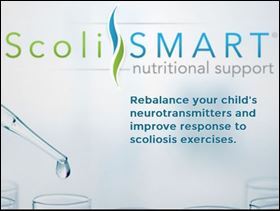Neurotransmitter Re-Balancing May Hold the Key to Scoliosis Exercise Success
February 25, 2014 (PRLEAP.COM) Health News
It has been long recognized that adolescent idiopathic scoliosis is primarily a neuro/hormonal condition with the spinal curvature being the primary symptom, but the actual cause and pathological mechanism is still relatively a mystery. However, recent research in the field of neurotransmitter testing and re-balancing is shedding new light, and new hope on the idea of treating the underlying neuro/hormonal cause of the condition. The ScoliSMART Nutritional Support™ program has identified 5 specific neurotransmitter imbalances that may play a key role in the progression of the scoliosis condition and it's response to scoliosis exercise treatment. Dr. Mark Morningstar (ScoliSMART Clinic, Michigan) explains, "European research has been increasingly focused on studying the neurological and hormonal factors, causes, and effects of scoliosis. The newer proposed theories of scoliosis causation look at an interconnection between specific hormone levels and the brain's sensitivity to them. Various hormones, such as leptin, melatonin, calmodulin, and growth hormone have all been looked at in cases of scoliosis."Although the human cerebellum is not considered as part of the endocrine system, the external zone of the cerebellar molecular layer has a high density of melatonin receptors and new research by Manzoni, Miele, and Pompeiano et al have proposed that the melatonin deficit in idiopathic scoliosis patients has an inhibitory effect on the vestibule-spinal activity which could lead to abnormal activities of the cervical and spinal muscles. Impaired vestibular information from the cerebellum to the vestibular cortical network or alteration of this cortical network could also lead to an alteration of back muscle activities. Therefore, vestibulospinal, as well as corticospinal abnormal activities may be part of the mechanisms leading to the onset and progression of idiopathic scoliosis.
Scoliosis occurs in approximately 4.5 percent of the general population. Scoliosis occurs when the spine of the back forms a C or an S shaped curve. The incidence is greater in females than males. Scoliosis patients have symptoms such back pain, hip pain, leg pain, and muscle spasms and in severe cases digestive symptoms, trouble breathing, and significant disability. About 80 percent of all scoliosis cases are idiopathic (unknown cause).
A few symptoms that could indicate a person might have scoliosis are
-Uneven shoulders
-If you wear a shirt or blouse with horizontal stripes and the stripes seem to be going diagonal (this effect caused by body distortion from a curved spine)
-Rib cage sticks out on one side
Scoliosis is often first diagnosed during the teen years at a back to school physical or sports physical. For many years, scoliosis treatment consisted of watching and waiting, rigid back bracing for 23 hours a day for many years, or spinal surgery, depending on the degree of spinal curve.
The ScoliSMART treatment consists of head/body weighting, vibrational therapies, scoliosis traction table and Scoliosis Activity Suit™, and home exercises. Care is initiated by taking x-rays to determine the severity of the scoliosis by measuring the spinal curves (Cobb angles). The treatment involves 5 and 10 day in office treatment plans with personalized home rehab plans to stabilize the gains made during treatment, Dr. Clayton J. Stitzel (ScoliSMART Clinic, Pennsylvania) explains, "Our non-surgical scoliosis treatment program is based on a unique system of scoliosis exercises that actually supplements the stimulation the cerebellum portion of the brain isn't getting, because of the melatonin deficit. Essentially the scoliosis exercises are replacing the feedback the brain isn't getting in order to train the cerebellum and muscles to learn how to hold the spine in a straighter position automatically."
For more information on scoliosis, please visit these website http://www.Facebook.com/TreatingScoliosis and http://www.treatingscoliosis.com
